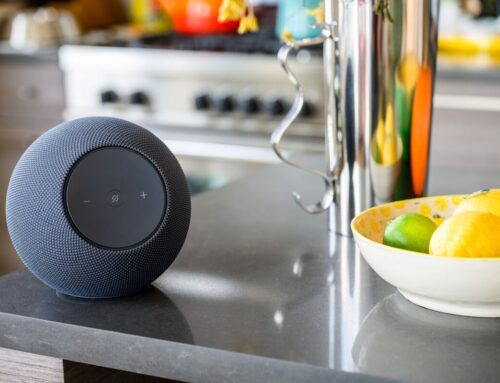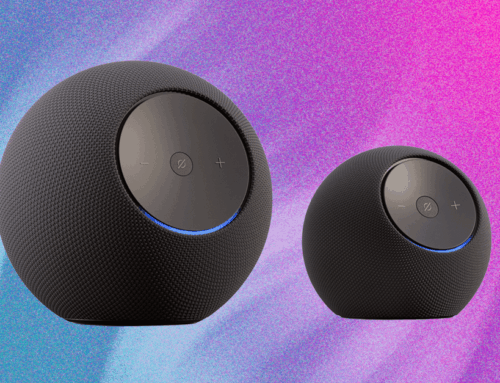The Echo Studio is a small speaker with big sound
October 29, 2025
The Atmos smart speaker goes up against the HomePod 2… and wins.


The majority of Amazon smart speakers lean more into the “smart” than the “speaker,” except for the Echo Studio. That device, which arrived in November 2019, was an imposing, sound-quality-first speaker that delivered Alexa functionality alongside impressive sound for a $200 device. But that was nearly six years ago — an eternity in tech product years — and the Studio has been due for a redesign.
The 2025 model of the Echo Studio, which costs $219.99, is one of four new Echo devices — alongside the Echo Dot Max, Echo Show 8, and Echo Show 11 — designed for Alexa Plus. Instead of the cylindrical design of its predecessor, it’s an orb, a bigger version of the new Dot Max with a flattened, angled side on the front that might bear a resemblance to a large space station in a galaxy far, far away.
The flattened circle is ringed with the blue Alexa light and has the volume up and down buttons flanking the mic mute button. When muted, the button glows red, but the full Alexa LED ring no longer lights up as the old Studio ring did, so it’s less visually intrusive.
The 3.5mm jack is gone from this version of the Studio, so the only way to listen to anything is by streaming from Amazon Music (an Unlimited subscription is required for Atmos), Spotify, Apple Music, iHeartRadio, Pandora, or SiriusXM. The Echo Studio has a new acoustically transparent 3D knit fabric that is only available in stealth gray and glacier white. If your heart is set on the striking amethyst colorway, your only choice is the Dot Max.
The Good
- Room-filling, well-balanced sound
- Attractive, smaller design than original Studio
- Built for Alexa Plus integration
- Five can be used together in a home theater
The Bad
- Bass doesn’t go as deep as competitors
- No 3.5mm input jack
Internally, the new Echo devices use new custom processors. The new chips, and particularly the Pro version, are designed to work better with Amazon Plus than those in earlier devices. Alexa was faster to respond to my queries, it heard me better from across the room, and my conversations ranging from upcoming heat advisories to groan-inducing jokes to questions about movies flowed more easily than before. (My colleague Jennifer Pattison Tuohy previously covered the new Alexa Plus smart home functionality and its agentic AI.)
While the Studio is the larger version of the Dot Max, it’s still 40 percent smaller than the original Studio, which is a welcome change. It’s only 6 inches across, which makes it much easier to fit on a shelf, bedroom dresser, or kitchen counter without looking and feeling oppressive. But the reduced size also means fewer and smaller speakers. The original Studio had five drivers: a ported 5.25-inch downward-firing woofer, three 2-inch midrange drivers, and a 1-inch tweeter. The 2025 version uses a high-excursion 3.75-inch woofer (high excursion means the driver can move a greater distance for potentially more bass) and three 1.5-inch full-range drivers for a total of four speakers. Not only is the new Studio smaller with fewer speakers, it has a 50-watt amplifier, down from a whopping 330-watt amp in the first incarnation.
Don’t assume the smaller footprint means a compromised sound. While the new Studio doesn’t get quite as loud as the original, it still delivers a big sound for its size, and in some ways is an improvement. For comparative listening, I lined up the original Studio, the 2025 Studio, and a second-generation HomePod on a dresser. To make sure one didn’t get a placement advantage over another (particularly for bass response, which is affected by proximity of walls), I rotated the lineup, keeping them about half a foot apart at all times. I used the same mixes of the same music tracks from both Amazon Music Unlimited (for the Studios) and Apple Music (for the HomePod), and all tracks were level-matched across the speakers as best as possible. The original Studio gets a good bit louder than the new one, so I consistently had its volume slider lower to match the other two speakers. It also only moves in increments of 10 percent, while the 2025 Studio (and HomePod) has more granular volume control.
The 2025 Echo Studio is the best-sounding speaker of the three. Where the original Studio’s bass response is a bit broader and, honestly, a bit flappy and unfocused, the bass of the new Studio sounds tighter and more accurate. The bass notes of Billie Eilish’s “bury a friend” have a better release that gives the sound a little more punch. The HomePod can better produce deeper frequencies, but they aren’t as strong and balanced in the mix as the Studio. The HomePod is also far more tuned to the high end, so the sound is more piercing. The Studio’s high-end frequencies have a bit of a harsh edge to them at higher volumes, but I didn’t find the sound unpleasant, just overly bright when loud.
What sold me most on the 2025 Studio’s sound is how it handles the midrange. Elton John is fully present and front and center during the verses on “Rocket Man” and soars through the room as the song hits the chorus, supported by background ooohs. And in “Spoonman” by Soundgarden, where the midrange gets busy, Chris Cornell’s voice still cuts through the distorted guitars.
One of the benefits of the 2025 Echo Studio over the Dot Max is its support for spatial audio. And when listening to Dolby Atmos mixes, the soundstage is comparable to its predecessor. You can hear mix elements, such as the dentist drill punctuations in “bury a friend,” move through the room. But it has the same issue as any single speaker that attempts to reproduce spatial audio. To get the full effect, you need to be sitting directly in front of it, and even then it’s a shadow of what a multi-speaker spatial audio system can achieve. Smart speakers like the Studio are meant to play as you move around the room, not as you sit for a critical listening session.
When paired with a compatible Fire TV device — the Fire TV Stick 4K (2nd gen), Fire TV Stick 4K Max (2nd gen), and Fire TV Cube (3rd gen) — you’ll be able to use up to five Echo Studio smart speakers in a surround sound setup. That’s around $1,100 for a full five-speaker system, unless Amazon releases a bundle. It’s comparable in pricing to the new TCL Z100 Flex Connect speakers or Hisense Saturn HT, but those don’t have the same smart home integration. Alexa Home Theater support is not available yet, though, so I was unable to test the capability, but the Atmos performance of the single speaker could bode well. We’ll update when it’s available.
The 2025 Echo Studio is a more attractive, fully capable smart speaker that sounds even a bit better than the original Studio. With a more powerful processor for Alexa Plus, the ability to link up with your Fire TV system, and a lower price than the HomePod, the Echo Studio is a great successor for an Amazon household.
Photography by John Higgins / The Verge
Search
RECENT PRESS RELEASES
Related Post








